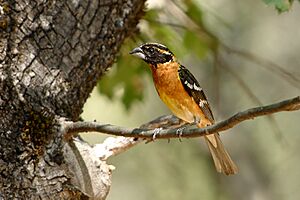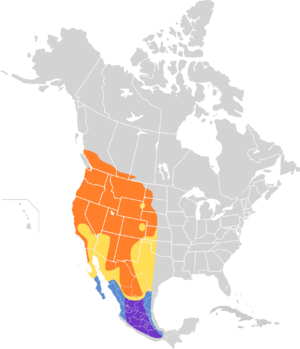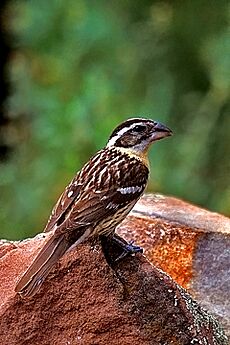Black-headed grosbeak facts for kids
Quick facts for kids Black-headed grosbeak |
|
|---|---|
 |
|
| Male in California, United States | |
| Conservation status | |
| Scientific classification | |
| Genus: |
Pheucticus
|
| Species: |
melanocephalus
|
 |
|
| Breeding
Migration Year-round Nonbreeding |
|
The black-headed grosbeak (Pheucticus melanocephalus) is a medium-sized bird known for eating seeds. It belongs to the Cardinalidae family, which includes cardinals and buntings. This bird is sometimes thought to be the same species as the rose-breasted grosbeak. They even mix and have babies together in the American Great Plains.
This migratory bird is about 19 cm (7.5 in) long and weighs around 47 grams (1.7 oz). It nests from southwestern British Columbia, across the western United States, and into central Mexico. Sometimes, it travels further south into Central America as a vagrant.
Discover the Black-Headed Grosbeak
What Does a Black-Headed Grosbeak Look Like?
The black-headed grosbeak is about the same size as a common starling. The male bird has a black head, black wings, and a black tail with bright white spots. Its chest is a dark orange color, and its belly is yellow.
The female grosbeak looks different. She has a brown head, neck, and back with dark streaks, similar to a sparrow. She also has white streaks on her head, above her eyes, and on her cheeks. Her chest is white. Her wings and tail are grayish-brown with two white bars on her wings and yellowish edges.
How Big Are They?
- Length: 18 to 19 cm (7.1 to 7.5 in)
- Weight: 34 to 48 grams (1.2 to 1.7 oz)
- Wingspan: About 32 cm (12.6 in)
Where Do Black-Headed Grosbeaks Live?
Black-headed grosbeaks prefer to live in forests with deciduous trees (trees that lose their leaves) and mixed wooded areas. They like places with tall trees and thick bushes. You can often find them near streams, rivers, lakes, wetlands, and even in suburban areas. They enjoy patches of broadleaved trees and shrubs within conifer forests.
Life Cycle and Nesting Habits
Female grosbeaks build their nests in dense leaves on the outer branches of tall trees or shrubs. These nests are usually 1 to 11 meters (3 to 35 ft) above the ground. Sometimes, they build nests in thick bushes like blackberry plants.
The nest is shaped like an open saucer. It is made from fine grass, small roots, twigs, bark, and pine needles. The inside is often lined with soft materials like roots, hair, and plant fibers. The female lays two to five eggs. These eggs are pale green, blue, or gray and have reddish and dark brown spots.
Both the male and female take turns sitting on the eggs to keep them warm. This is called incubation and lasts for 12 to 14 days. After the eggs hatch, the baby birds, called fledglings, stay in the nest for about 11 or 12 days. They cannot fly for another two weeks after leaving the nest. Both parents feed the young birds.
Black-headed grosbeaks usually stay with one partner for a single breeding season. They typically raise one group of babies each year. However, in some areas, like the foothills of the Sacramento Valley in California, they have been known to raise two groups.
The Grosbeak's Song
The song of the black-headed grosbeak is a rich, flowing tune. It sounds a bit like an American robin's song, but it's smoother, faster, and softer. It has sweet, rising and falling parts that make it longer than a robin's song. The bird also makes a sharp "ik" or "eek" sound. Both male and female grosbeaks sing, but their songs are different. They even sing while sitting on the nest!
What Do Black-Headed Grosbeaks Eat?
Black-headed grosbeaks enjoy a varied diet. They eat pine seeds, other types of seeds, berries, insects, spiders, and fruits. During the summer, their diet mainly consists of spiders, snails, and insects.
A Special Diet: Monarch Butterflies
This bird has a very interesting diet choice: it can safely eat the monarch butterfly. Monarch butterflies are poisonous to most other birds because they contain special chemicals from the milkweed plants they eat as caterpillars. However, the black-headed grosbeak is one of the few birds that can eat them without getting sick.
Scientists have found that the black-headed grosbeak has a unique ability to handle these poisons. Over many years, its body developed a special way to protect itself from the monarch's toxins. This is similar to how some insects that feed on poisonous plants also became resistant. In their winter homes in Mexico, these grosbeaks eat many monarch butterflies, possibly over a million each year!
During the breeding season, black-headed grosbeaks often visit bird feeders. They enjoy sunflower seeds, other seeds, and fruit. They also join northern orioles at feeders that offer grape jelly.
Where Do They Travel?
Black-headed grosbeaks live from the Pacific Coast all the way to the middle of the US Great Plains. Their range extends from southwestern Canada down to the mountains of Mexico.
Birds living in the US and Canada are migratory. This means they travel south to Mexico for the winter. In the Great Plains, the areas where black-headed grosbeaks and rose-breasted grosbeaks live overlap. Because of this, they sometimes breed together. After the breeding season, they often look for areas rich in berries. They fly south early in the fall and return north late in the spring, sometimes traveling in large groups.
How Do Black-Headed Grosbeaks Behave?
Black-headed grosbeaks often sing from high, noticeable spots. Both males and females sing, even when they are incubating eggs in the nest. When a male wants to attract a female, he flies with his wings and tail spread wide.
They search for food among leaves, on the ground, or in low bushes. They are known for eating many berries. When baby grosbeaks want food, they sing to their mother, rustle their wings, and show off their yellow belly feathers.
Images for kids
See also
 In Spanish: Picogrueso cabecinegro para niños
In Spanish: Picogrueso cabecinegro para niños




